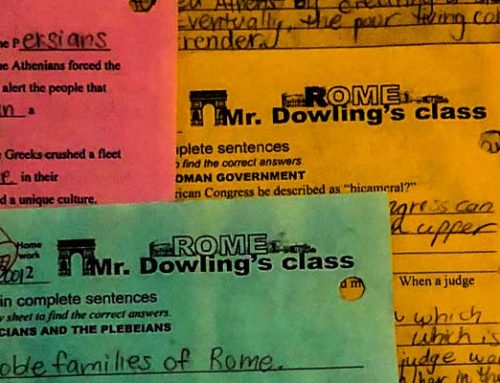In about 1450, European scholars became more interested in studying the world around them. At the same time, European artists produced work that was more true to life. And European ships set sail to explore new lands. This new age in Europe was eventually called the Renaissance, a French word that means rebirth.
The Renaissance began in northern Italy and then spread over the next century through Europe. Italian cities such as Naples, Genoa, and Venice became trade centers between Europe and the Middle East. In the Middle East, Arab scholars preserved the writings of the ancient Greeks in great libraries. So, when these Italian cities traded with Arab merchants, the Italians were reconnected with the ideas of the ancient Greeks. These “new” ideas, preserved from the ancient past, served as the basis of the Renaissance.
Foreign trade made many Italian merchant families wealthy. These families became patrons who commissioned great paintings, sculptures, and architecture. During the Renaissance, paintings, and sculptures became more realistic and focused less often on religious topics. Artists advanced the Renaissance style of showing nature and depicting people’s feelings.

Vitruvian_Man
Leonardo da Vinci’s Vitruvian Man (c. 1487) depicts what the artist believed were the perfect proportions of human anatomy.
In AD324, the Roman Empire was under attack, so Emperor Constantine moved his capital 850 miles east to Byzantium, a Greek-speaking city he renamed Constantinople. Visigoth warriors overran Rome in 410, but Constantinople remained an influential city and a center of Christianity for a century. The Byzantine Empire fell to Muslim Turks in 1453, prompting many Greek-speaking Christian scholars to move to Italy.
The rebirth of Europe led to a flowering of music, literature, and drama that included the plays of William Shakespeare. Johann Gutenberg’s invention of the printing press in 1439 allowed ideas to spread far from their native cultures.
European adventurers explored places farther from their homelands during the Renaissance. In 1492, a Spanish fleet led by Christopher Columbus sailed to the Americas. This spirit of discovery and innovation is why historians consider the Renaissance to be the beginning of modern history.

Italy_in_1494
Present day Italy is a unified nation, but during the Renaissance, the Italian peninsula was composed of several independent city-states.

Raphael’s The School of Athens (1511) depicts a congregation of philosophers, mathematicians, and scientists from Ancient Greece. It is an example of Renaissance artists looking back to the Classical Age.
Resources
Download this lesson as Microsoft Word file or as an Adobe Acrobat file.
Lexile Measure 1030L
Mean Sentence Length 14.75
Mean Log Word Frequency 3.35
Word Count 354
Mr. Donn has an excellent website that includes a section on the Renaissance.
Learning and the Arts began to flourish during the Renaissance.
- Wealthy families and the church had amassed enough wealth to become patrons.
- The invention of the printing press encouraged literacy and helped to spread new ideas.
- The 1564 discovery of a graphite mine in England and the development of Chinese papermaking in Europe made writing easier for people.
- Developing financial techniques such as bookkeeping and credit allowed merchants to prosper.
Resources for Time and Space – A Personal Journey
The Renaissance: Dawn of a New Age
About 1450, European scholars became more interested in studying the world around them. At the same time, European artists produced work that was more true to life. And European ships set sail to explore new lands. This new age in Europe was eventually called “the Renaissance”, a French word that means “rebirth.”
The Renaissance began in northern Italy and then spread over the next century through Europe. Italian cities such as Naples, Genoa, and Venice became centers of trade between Europe and the Middle East. In the Middle East, Arab scholars had preserved the writings of the ancient Greeks in great libraries. So, when these Italian cities traded with Arab merchants, the Italians were reconnected with the ideas of the ancient Greeks. These “new” ideas, preserved from the ancient past, served as the basis of the Renaissance.
Foreign trade made many Italian merchant families wealthy. These families became patrons who commissioned great painting, sculpture, and architecture. During the Renaissance, paintings and sculptures became more realistic and focused less often on religious topics. Artists advanced the Renaissance style of showing nature and depicting the feelings of people.
In AD324, the Roman Empire was under attack, so Emperor Constantine moved his capital 850 miles east to Byzantium, a Greek-speaking city he renamed Constantinople. Visigoth warriors overran Rome in 410, but Constantinople remained a powerful city and a center of Christianity for a century. The Byzantine Empire fell to Muslim Turks in 1453, prompting many Greek-speaking Christian scholars to move to Italy.
The printing press allowed the ideas of the era to spread far from their native cultures. The Renaissance led to a flowering of music, literature and drama that included the plays of William Shakespeare.
Resources
Download this lesson as Microsoft Word file or as an Adobe Acrobat file.
Lexile Measure 1030L
Mean Sentence Length 14.75
Mean Log Word Frequency 3.35
Word Count 354
Mr. Donn has an excellent website that includes a section on the Renaissance.

Leonardo da Vinci’s Vitruvian Man (c. 1487) depicts what the artist believed were the perfect proportions of human anatomy.

Present day Italy is a unified nation, but during the Renaissance, the Italian peninsula was composed of several independent city-states. Genoa, Milan, and Venice were among the most important. By this date the Turkish Ottoman Empire (on the right side of the map) replaced the Byzantine Empire.
Learning and the Arts began to flourish during the Renaissance
- Wealthy families and the church had amassed enough wealth to become patrons.
- The invention of the printing press encouraged literacy and helped to spread new ideas.
- The 1564 discovery of a graphite mine in England and the development of Chinese papermaking in Europe made it easier for people to write.
- The development of financial techniques such as bookkeeping and credit allowed merchants to prosper.




